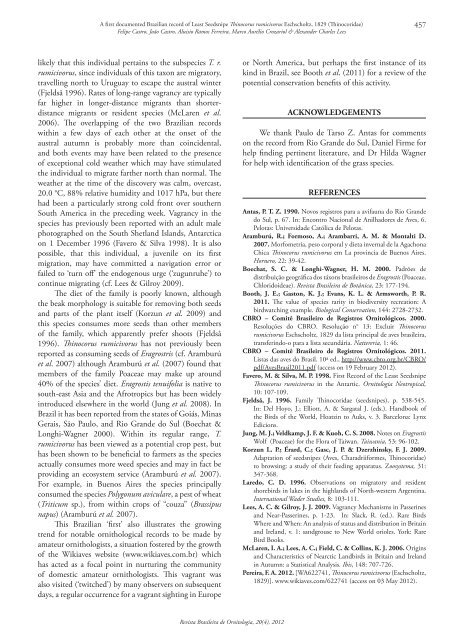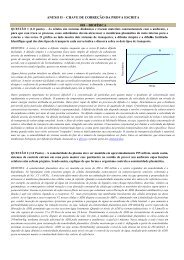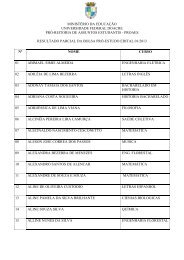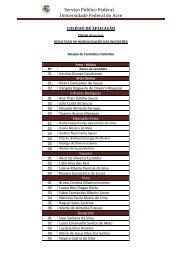Revista Brasileira de Ornitologia - Universidade Federal do Acre
Revista Brasileira de Ornitologia - Universidade Federal do Acre
Revista Brasileira de Ornitologia - Universidade Federal do Acre
Create successful ePaper yourself
Turn your PDF publications into a flip-book with our unique Google optimized e-Paper software.
A first <strong>do</strong>cumented Brazilian record of Least Seedsnipe Thinocorus rumicivorus Eschscholtz, 1829 (Thinocoridae)Felipe Castro, João Castro, Aluisio Ramos Ferreira, Marco Aurélio Crozariol & Alexan<strong>de</strong>r Charles Lees457likely that this individual pertains to the subspecies T. r.rumicivorus, since individuals of this taxon are migratory,travelling north to Uruguay to escape the austral winter(Fjeldså 1996). Rates of long-range vagrancy are typicallyfar higher in longer-distance migrants than shorterdistancemigrants or resi<strong>de</strong>nt species (McLaren et al.2006). The overlapping of the two Brazilian recordswithin a few days of each other at the onset of theaustral autumn is probably more than coinci<strong>de</strong>ntal,and both events may have been related to the presenceof exceptional cold weather which may have stimulatedthe individual to migrate farther north than normal. Theweather at the time of the discovery was calm, overcast,20.0 °C, 88% relative humidity and 1017 hPa, but therehad been a particularly strong cold front over southernSouth America in the preceding week. Vagrancy in thespecies has previously been reported with an adult malephotographed on the South Shetland Islands, Antarcticaon 1 December 1996 (Favero & Silva 1998). It is alsopossible, that this individual, a juvenile on its firstmigration, may have committed a navigation error orfailed to ‘turn off’ the en<strong>do</strong>genous urge (‘zugunruhe’) tocontinue migrating (cf. Lees & Gilroy 2009).The diet of the family is poorly known, althoughthe beak morphology is suitable for removing both seedsand parts of the plant itself (Korzun et al. 2009) andthis species consumes more seeds than other membersof the family, which apparently prefer shoots (Fjeldså1996). Thinocorus rumicivorus has not previously beenreported as consuming seeds of Eragrostris (cf. Aramburúet al. 2007) although Aramburú et al. (2007) found thatmembers of the family Poaceae may make up around40% of the species’ diet. Eragrostis tenuifolia is native tosouth-east Asia and the Afrotropics but has been wi<strong>de</strong>lyintroduced elsewhere in the world (Jung et al. 2008). InBrazil it has been reported from the states of Goiás, MinasGerais, São Paulo, and Rio Gran<strong>de</strong> <strong>do</strong> Sul (Boechat &Longhi-Wagner 2000). Within its regular range, T.rumicivorus has been viewed as a potential crop pest, buthas been shown to be beneficial to farmers as the speciesactually consumes more weed species and may in fact beproviding an ecosystem service (Aramburú et al. 2007).For example, in Buenos Aires the species principallyconsumed the species Polygonum aviculare, a pest of wheat(Triticum sp.), from within crops of “couza” (Brassipusnapus) (Aramburú et al. 2007).This Brazilian ‘first’ also illustrates the growingtrend for notable ornithological records to be ma<strong>de</strong> byamateur ornithologists, a situation fostered by the growthof the Wikiaves website (www.wikiaves.com.br) whichhas acted as a focal point in nurturing the communityof <strong>do</strong>mestic amateur ornithologists. This vagrant wasalso visited (‘twitched’) by many observers on subsequentdays, a regular occurrence for a vagrant sighting in Europeor North America, but perhaps the first instance of itskind in Brazil, see Booth et al. (2011) for a review of thepotential conservation benefits of this activity.ACKNOWLEDGEMENTSWe thank Paulo <strong>de</strong> Tarso Z. Antas for commentson the record from Rio Gran<strong>de</strong> <strong>do</strong> Sul, Daniel Firme forhelp finding pertinent literature, and Dr Hilda Wagnerfor help with i<strong>de</strong>ntification of the grass species.REFERENCESAntas, P. T. Z. 1990. Novos registros para a avifauna <strong>do</strong> Rio Gran<strong>de</strong><strong>do</strong> Sul, p. 67. In: Encontro Nacional <strong>de</strong> Anilha<strong>do</strong>res <strong>de</strong> Aves, 6.Pelotas: Universida<strong>de</strong> Católica <strong>de</strong> Pelotas.Aramburú, R.; Formoso, A.; Arambarri, A. M. & Montalti D.2007. Morfometría, peso corporal y dieta invernal <strong>de</strong> la AgachonaChica Thinocorus rumicivorus em La provincia <strong>de</strong> Buenos Aires.Hornero, 22: 39-42.Boechat, S. C. & Longhi-Wagner, H. M. 2000. Padrões <strong>de</strong>distribuição geográfica <strong>do</strong>s táxons brasileiros <strong>de</strong> Eragrostis (Poaceae,Chlori<strong>do</strong>i<strong>de</strong>ae). <strong>Revista</strong> <strong>Brasileira</strong> <strong>de</strong> Botânica, 23: 177-194.Booth, J. E.; Gaston, K. J.; Evans, K. L. & Armsworth, P. R.2011. The value of species rarity in biodiversity recreation: Abirdwatching example. Biological Conservation, 144: 2728-2732.CBRO – Comitê Brasileiro <strong>de</strong> Registros Ornitológicos. 2000.Resoluções <strong>do</strong> CBRO. Resolução n° 13: Excluir Thinocorusrumicivorus Eschscholtz, 1829 da lista principal <strong>de</strong> aves brasileira,transferin<strong>do</strong>-o para a lista secundária. Nattereria, 1: 46.CBRO – Comitê Brasileiro <strong>de</strong> Registros Ornitológicos. 2011.Listas das aves <strong>do</strong> Brasil. 10ª ed., http://www.cbro.org.br/CBRO/pdf/AvesBrasil2011.pdf (access on 19 February 2012).Favero, M. & Silva, M. P. 1998. First Record of the Least SeedsnipeThinocorus rumicivorus in the Antartic. <strong>Ornitologia</strong> Neotropical,10: 107-109.Fjeldså, J. 1996. Family Thinocoridae (seedsnipes), p. 538-545.In: Del Hoyo, J.; Elliott, A. & Sargatal J. (eds.). Handbook ofthe Birds of the World, Hoatzin to Auks, v. 3. Barcelona: LynxEdicions.Jung, M. J.; Veldkamp, J. F. & Kuoh, C. S. 2008. Notes on EragrostisWolf (Poaceae) for the Flora of Taiwan. Taiwania, 53: 96-102.Korzun L. P.; Érard, C.; Gasc, J. P. & Dzerzhinsky, F. J. 2009.Adaptation of seedsnipes (Aves, Charadriiformes, Thinocoridae)to browsing: a study of their feeding apparatus. Zoosystema, 31:347-368.Lare<strong>do</strong>, C. D. 1996. Observations on migratory and resi<strong>de</strong>ntshorebirds in lakes in the highlands of North-western Argentina.International Wa<strong>de</strong>r Studies, 8: 103-111.Lees, A. C. & Gilroy, J. J. 2009. Vagrancy Mechanisms in Passerinesand Near-Passerines, p. 1-23. In: Slack, R. (ed.). Rare BirdsWhere and When: An analysis of status and distribution in Britainand Ireland, v. 1: sandgrouse to New World orioles. York: RareBird Books.McLaren, I. A.; Lees, A. C.; Field, C. & Collins, K. J. 2006. Originsand Characteristics of Nearctic Landbirds in Britain and Irelandin Autumn: a Statistical Analysis. Ibis, 148: 707-726.Pereira, F. A. 2012. [WA622741, Thinocorus rumicivorus (Eschscholtz,1829)]. www.wikiaves.com/622741 (access on 03 May 2012).<strong>Revista</strong> <strong>Brasileira</strong> <strong>de</strong> <strong>Ornitologia</strong>, 20(4), 2012










